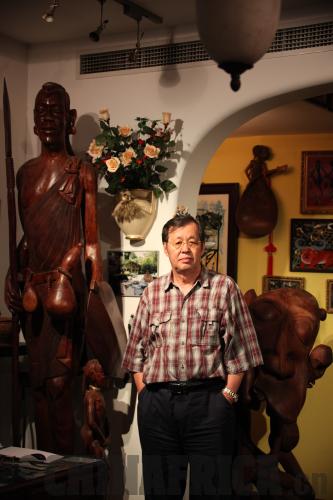| 
What is Makonde art? How did you end up devoting your life to it?
Few have heard of Makonde, but people may look at it with new eyes once they realize that even Picasso drew inspiration from it. The wood carvings are traditional art works from Tanzania. The name "Makonde" refers to the Makonde ethnic group. While it is famed in East Africa, it has also greatly influenced international modern art. European artists discovered Makonde art in the 19th century, and saw it as a new art language. Cubism was created and inspired by Makonde art.
I started working in Africa in the early 1970s and became obsessed with the sculptures. Each work is unparalleled. There are no two ones the same, and it's impossible to copy. Makonde art is the cream of African art.
African art is sometimes described as "primitive." Do you think this is the case?
It's unreasonable for art academia to claim that there is no modern art in Africa. Makonde art dates very far back from now, but I think it's also a modern art. With exaggerated appearance, grotesque posture or ugly countenance, the sculptures embody the fantasies of artists. Some say it's hard to understand these works, but I think art is about feeling rather than profound theories. Or as Picasso put it, "Everyone wants to understand art. Why is there no attempt to understand the song of the birds?" Art, beautiful or ugly, is worthy of appreciation when it can inspire reverie.
You have spent a lot of money on the sculptures over the years. Why donate them all to a museum?
My father predicted that one day I would donate them to a public institution. I have kept one or two to decorate my home, but I don't need to keep them all.
My wife and I have spent more than 20 years in Africa, collecting over 10,000 pieces but never selling one. Many of the sculptors are our friends. They also want to keep their works in a museum. On the one hand, to put these works in a museum gives more people a chance to learn about African culture and art. On the other hand, it's also the wish of the African artists. Most importantly, as a member of China's first generation of intellectuals devoted to Africa-related work, I've learned their language and built connections between China and Africa in areas like economy, politics and culture. To promote the communication between the two regions has become my responsibility.
You describe your work with Makonde art as "a hard cultural journey." Why then do you enjoy it so much?
Every nation experiences ups and downs during its cultural development. Independence movements in African countries in the 1960s boosted wood carvings. I discovered this fabulous art form in the following decades and collected many works by Makonde masters. I went through so much hardship to bring them to China and donate them. Many thought I was a fool; they didn't understand why I didn't sell the sculptures. I am in my 70s and have no desire for fame or wealth. Bringing Makonde to China and introducing it to Chinese artists, this is my contribution and what makes me content.
I was awarded by two Tanzanian presidents. I hope the museum can attract more young people to embark on this hard journey, promoting communication between China and Africa. |